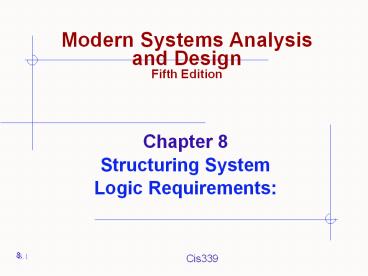Modern Systems Analysis and Design Fifth Edition - PowerPoint PPT Presentation
Title:
Modern Systems Analysis and Design Fifth Edition
Description:
Activity diagram Structured English Decision Tables Decision Trees State-transition diagrams Sequence diagrams Activity diagrams Modeling Logic with Structured ... – PowerPoint PPT presentation
Number of Views:188
Avg rating:3.0/5.0
Title: Modern Systems Analysis and Design Fifth Edition
1
Modern Systems Analysisand DesignFifth
Edition
- Chapter 8
- Structuring System
- Logic Requirements
8.1
2
Learning Objectives
- Use Structured English as a tool for representing
steps in logical processes in data flow diagrams - Use decision tables and decision trees to
represent the logic of choice in conditional
statements - Select among Structured English, decision tables,
and decision trees for representing processing
logic
8.2
3
Logic Modeling
- Data flow diagrams do not show the logic inside
the processes - Logic modeling involves representing internal
structure and functionality of processes depicted
on a DFD - Logic modeling can also be used to show when
processes on a DFD occur
8.3
4
Modeling a Systems Logic
5
Logic Modeling
- Deliverables and Outcomes
- Structured English representation of process
logic. - Decision Tables representation.
- Sequence diagram.
- Activity diagram
- Structured English
- Decision Tables
- Decision Trees
- State-transition diagrams
- Sequence diagrams
- Activity diagrams
8.5
6
Modeling Logic with Structured English
- Structured English modified form of English
language used to specify the logic of information
system processes. - No single standard.
- Typically relies on action verbs and noun phrases
and contains no adjectives or No specific
standards. - Uses a subset of English
- Action verbs
- Noun phrases
- No adjectives or adverbs
- No specific standards
8.6
7
Modeling Logic with Structured English
8
Modeling Logic with Structured English
9
Modeling Logic with Decision Tables
- A matrix representation of the logic of a
decision which Specifies the possible conditions
and the resulting actions - Best used for complicated decision logic
8.9
10
Figure 9-4Complete decision table for payroll
system example
11
Modeling Logic withDecision Tables
- Consists of three parts
- Condition stubs that part of a decision table
that lists the conditions relevant to the
decision. - Action stubs that part of a decision table that
lists the actions that result for a given set of
conditions. - Rules that part of a decision table that
specifies which actions are to be followed for a
given set of condition.
8.11
12
Modeling Logic with Decision Tables
- Indifferent Condition
- Indifferent condition in a decision table, a
condition whose value does not affect which
actions are taken for two or more rules. - Procedure for Creating Decision Tables
- Name the condition and values each condition can
assume - Name all possible actions that can occur
- List all rules
- Define the actions for each rule
- Simplify the table( remove any rules which has no
actions)
8.12
13
Figure 9-4simplify decision table for payroll
system example
8.13
14
Decision Table for Hoosier Burgers Inventory
reordering
15
Simplified Decision Table for Hoosier Burgers
Inventory reordering
16
Modeling Logic with Decision Trees
- A graphical representation of a decision
situation - Decision situation points (nodes) are connected
together by arcs and terminate in ovals - Two main components
- Decision points represented by nodes
- Actions represented by ovals
- Read from left to right
- Each node corresponds to a numbered choice on a
legend - All possible actions are listed on the far right
8.16
17
Figure 9-9Decision tree representation of the
decision logic in the decision tables in Figures
9-4 and 9-5, with only two choices per decision
point
8.17
18
Deciding Among Structured English, Decision
Tables and Decision Trees
Criteria Structured English Decision Tables Decision Trees
Determining Conditions and Actions Second Best Third Best Best
Transforming Conditions and Actions into Sequence Best Third Best Best
Checking Consistency and Completeness Third Best Best Best
8.18
19
Deciding Between Table and Tree
Criteria Decision Table Decision Tree
Portraying complex logic Best Worst
Portraying simple problem Worst Best
Making decision Worst Best
More compact Best Worst
Easier to manipulate Best Worst

